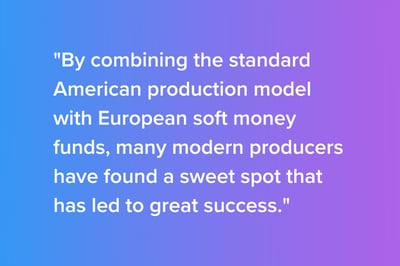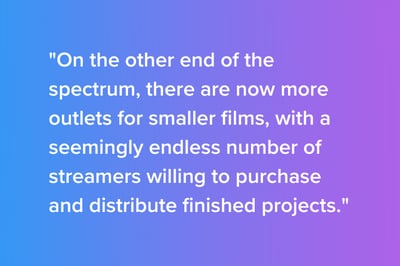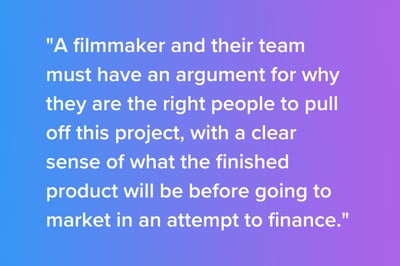In part one of our 2022 AFM recap, we covered the many ways in which streaming and VOD have impacted the financing and packaging of modern productions. New audience behaviors and demands are dictating the kinds of content being produced, from studio tentpoles to smaller budgeted independent fare. With costs rising and traditional distribution structures in question, how does one put together a project that can see itself across the finish line?
With independent financing, adjustments are becoming more and more necessary as the traditional pre-sales model goes out of style. “Pre-sales are not what they used to be,” mentioned Maxime Cottray. “The paradigm five to ten years ago was pre-sales plus gap plus tax incentives equals your budget, but that pre-sale number has dwindled, and the gap is more risky.” But when funding a smaller project, modern filmmakers still have several options at their disposal. Equity financiers, for one, read everything. They are traditionally fairly hands on, often getting involved at the script stage to ensure their investment. They like to read the script and any associated materials relating to the project in order to gain a sense of the whole package. Soft money from certain European governments can be a wonderful option for producers interested in co-productions who are willing to “passport” talent and crew across the border. Cottray added, “On some movies, we get 80 percent of our budget  [from the government] ... so we reimagine the formula: if pre-sales used to be 50 percent, they're now 20 percent. Well, how do I replace the 30 percent?” This money is usually provided through government grants and foundations (like the BBC or BFI) that aim to stimulate local economies. These money streams often come with the condition that a production be made up of a certain percentage of local crew people and talent. By combining the standard American production model with European soft money funds, many modern producers have found a sweet spot that has led to great success.
[from the government] ... so we reimagine the formula: if pre-sales used to be 50 percent, they're now 20 percent. Well, how do I replace the 30 percent?” This money is usually provided through government grants and foundations (like the BBC or BFI) that aim to stimulate local economies. These money streams often come with the condition that a production be made up of a certain percentage of local crew people and talent. By combining the standard American production model with European soft money funds, many modern producers have found a sweet spot that has led to great success.
Despite the alarm bells, don’t believe everything you hear—pre-sales are not entirely dead! These kinds of deals just tend to have more specific demands attached to them. As Graham noted, "The pre-sale market does give you an indication of what people think your film is worth … There's been this disconnect between what you spend and what you get [when you sell]." In these circumstances, a project will need an exceptional script, a stellar cast, and a workable budget to get past the starting line. Cottray remembered, “The ‘eureka!’ moment was to take the American approach; make [films] more cast driven, more commercially driven, and you combine that with the European soft money structure. And in practice, it's worked brilliantly for us." Specificity is key, so producers should know their targeted audience and build the project accordingly. And while it can be uncomfortable to lean into the worst-case scenarios, it is important to budget with the most pessimistic assumptions.
“As a lender, we do think about [theatrical] before we put the money in, but it is generally to make the most pessimistic assumption,” explained Deirdre Owens. “We think about theatrical and whether or not it will limit some of the upside. We are thinking about [theatrical], but the assumption is it won't happen unless there is a signed contract with a distributor that is guaranteed to release it on screens.” Producers should assume that they won’t get a theatrical release when approaching lenders (unless, of course, there is already a deal in place). On the occasion where a project is nearly completely funded, gap loans are available to fill in the … well, gap. However, these loans often come at a greater cost. Lenders will require assurances that the concept will work, and they will likely consider both context and content. Debt financiers are not typically concerned with the content of the film in any specific sense, as they usually become involved later in the financing process after multiple investors and sales agents get involved, or after minimum guarantees and tax incentives have been issued or promised. For them, that’s likely enough assurance for a loan.
Tax incentives, while extremely helpful to a production budget, are quite competitive—especially in established industry states like California, New York, and Georgia. Most of a location’s allotted credits are quickly eaten up by studios and streamers, who take priority because of their stature and repeat business. According to Owens, “Streamers are taking the place of studios in some of these jurisdictions, using up [the incentives] … Film commissions accommodate some of the big players, and there's not a huge impact from VOD on the incentives space.” Independent films are often left behind in the complicated web of incentives financing, often waiting years for help that never comes. Graham warns that “[state incentive spend] minimums can preclude smaller productions. And when you go to a place like Georgia, they want to recruit the massive Marvel films ... Some jurisdictions are taking a very long time to process these smaller independents. There are some places where we are waiting for years to get paid back.” Might this fact open doors for new locations to offer exciting incentives? There are still countries and locales where streaming’s presence remains underdeveloped, though theatrical is still quite alive in these places. Surely, an overstuffed production industry might seek out new areas in which to film, assuming these places can offer value (while luring Hollywood a bit closer to home).
So, where do things stand with distribution in the changing relationship between streaming and theatrical? While the big streamers have established an effective way for filmmakers to reach audiences where they live, this convenience has had a notable (and negative) impact on theatrical attendance. While studios once put out a healthy and diverse annual slate of films with different budgets and targeting different audiences, today’s theatrical release schedule is mostly limited to carefully curated tentpoles and formula blockbusters. The big blockbusters once limited to the summer months have now permeated the calendar year-round. Occasionally, an exceptional independent film or nuanced studio picture will find itself with a healthy release window and box office legs (like 2020’s Parasite, for example), though these middle-class movies find themselves on fewer screens each year. On the other end of the spectrum, there are now more outlets for smaller films, with a seemingly endless number of streamers willing to purchase and distribute finished projects. However, the aggressive feeding frenzy of streaming’s early days is over, and platforms are searching for more quality products to release.
the calendar year-round. Occasionally, an exceptional independent film or nuanced studio picture will find itself with a healthy release window and box office legs (like 2020’s Parasite, for example), though these middle-class movies find themselves on fewer screens each year. On the other end of the spectrum, there are now more outlets for smaller films, with a seemingly endless number of streamers willing to purchase and distribute finished projects. However, the aggressive feeding frenzy of streaming’s early days is over, and platforms are searching for more quality products to release.
This new distribution model has also had a disruptive effect on talent contracts. To lure top above-the-line talent in the traditional theatrical model, lower-budget productions would offer them box office bonuses (points or participations) on the back end. As that figure no longer exists in the at-home model, some streamers are paying 10-20 percent up-front bonuses to bridge the gap. Cottray explains that "talent deals have become really hard over the years because the streamers overpaid for so long ... everyone was getting used to these rates, and that is incompatible with these independent movies.” This fairly new practice is only one of the reasons financing streamers has become more difficult. Often, productions must unravel previously held distribution deals in order to be sold. The streamers want to own the right to stream worldwide, and this becomes complicated with things like pre-sales. Therefore, distribution should always be considered in the financing stage. It is a good practice to finance with flexibility in mind. For example, the day-and-date model (where a film is simultaneously released in theaters and at home) has done wonders for promotion, bringing audiences to theaters and leading them to tune in at home. Considering the large cost of putting a film in theaters (often a bigger price tag than some indie movie budgets), it can be more practical to skew the showcasing ratio toward home audiences. In this way, the market decides where a film is distributed. It’s always best not to make assumptions when putting a project together. As Steven Farneth noted. “Even studios are going to hedge their bets and do what they feel is right.”
And if (fingers crossed) a film makes money … then what? How are profits divvied up in this evolving era? That depends on how a film is set up from the start. Money trickles down from the top, and it’s important to respect the waterfall. However, different project stakeholders may have different requirements relating to their place in that order. Debt financiers and lenders, for example, will almost always land near the top of the heap. There is still significant upside available to any smaller  independent project lucky enough to establish a theatrical presence, but that process can become quite muddled. Having good content is only a piece of the puzzle; as with most things, financial success can often be tied to an impactful marketing campaign. When films are dumped on VOD platforms, they’re not always given the awareness they need (that’s why every time you open one of the major streamers, you see an actor you love in a film you’ve never heard about). It is extremely important to plan for marketing expenses as early as possible in the budgeting process while remaining flexible enough to adapt to any sort of distribution deal that might come down the pipeline. Knowing whether a film has a theatrical deal or a streaming one dictates how a production will spend marketing dollars. "When I look around and see the companies that are winning,” remarked Steven Farnath, “it's ones that have a kind of old-fashioned idea of making something themselves and then choosing when and how we're going to take it to the marketplace … Historically, where there's opportunity the money follows, so I would imagine we will see more equity really coming back in a robust way to the market.”
independent project lucky enough to establish a theatrical presence, but that process can become quite muddled. Having good content is only a piece of the puzzle; as with most things, financial success can often be tied to an impactful marketing campaign. When films are dumped on VOD platforms, they’re not always given the awareness they need (that’s why every time you open one of the major streamers, you see an actor you love in a film you’ve never heard about). It is extremely important to plan for marketing expenses as early as possible in the budgeting process while remaining flexible enough to adapt to any sort of distribution deal that might come down the pipeline. Knowing whether a film has a theatrical deal or a streaming one dictates how a production will spend marketing dollars. "When I look around and see the companies that are winning,” remarked Steven Farnath, “it's ones that have a kind of old-fashioned idea of making something themselves and then choosing when and how we're going to take it to the marketplace … Historically, where there's opportunity the money follows, so I would imagine we will see more equity really coming back in a robust way to the market.”
As unstable as this period may feel at times, there are a few economic considerations that can be made with consistency. In the film industry, some things never change. For starters, creative talent will always be in demand. Audiences always want content to consume, and that requires the work of artists. Even in economic turmoil, a strategic producer with the right creative elements at their disposal will always be able to put forward a package that interests a financing partner. Many of the challenges remain consistent as well, such as attracting that kind of talent. Peter Graham mentioned, “For independents, the actors you want to get are on TV series and saying, 'can you squeeze me in between my shoot' … money doesn't necessarily get you an actor. You see a lot of projects that are funded but the actor availability [makes it a challenge to cast].” It also remains tricky to find territories that offer good rebates and incentives while fitting a project’s needs. And even when a director finally calls “that’s a wrap!” and sends their film to the cutting room, production still faces an uphill battle to secure distribution of some kind. Fortunately, things like the potential looming economic recession are not expected to have a major impact on production; entertainment tends to be recession proof, as people always clamor for distractions and experiences during hard times. The market is not as cyclical as it’s perceived in that way; there is always demand.
Our panelists hammered home a few key points, the most important being that filmmakers must know why they are telling a story. It comes back to the basics: Why now? With whom? A filmmaker and their team must have an argument for why they are the right people to pull off this project, with a clear sense of what the finished product will be before going to market in an attempt to finance. If a project’s basic story isn’t compelling enough, things may never get to the point of putting together a package of script and talent. To find success in today’s entertainment industry, every filmmaker must be an expert, reading, watching, listening, and always learning as much as possible. The simplest way to get started? Ask yourself: “Would I watch this?”
story. It comes back to the basics: Why now? With whom? A filmmaker and their team must have an argument for why they are the right people to pull off this project, with a clear sense of what the finished product will be before going to market in an attempt to finance. If a project’s basic story isn’t compelling enough, things may never get to the point of putting together a package of script and talent. To find success in today’s entertainment industry, every filmmaker must be an expert, reading, watching, listening, and always learning as much as possible. The simplest way to get started? Ask yourself: “Would I watch this?”
You may be surprised how clear your answer is.

